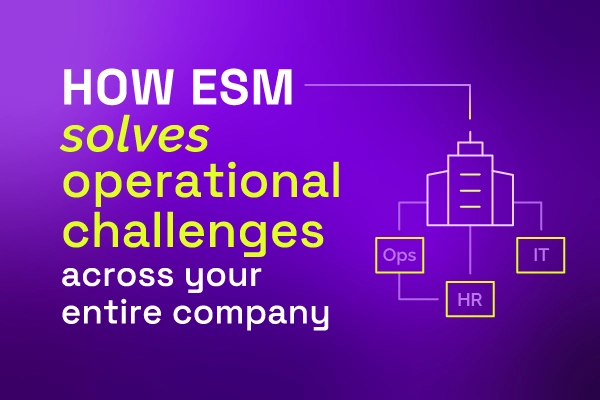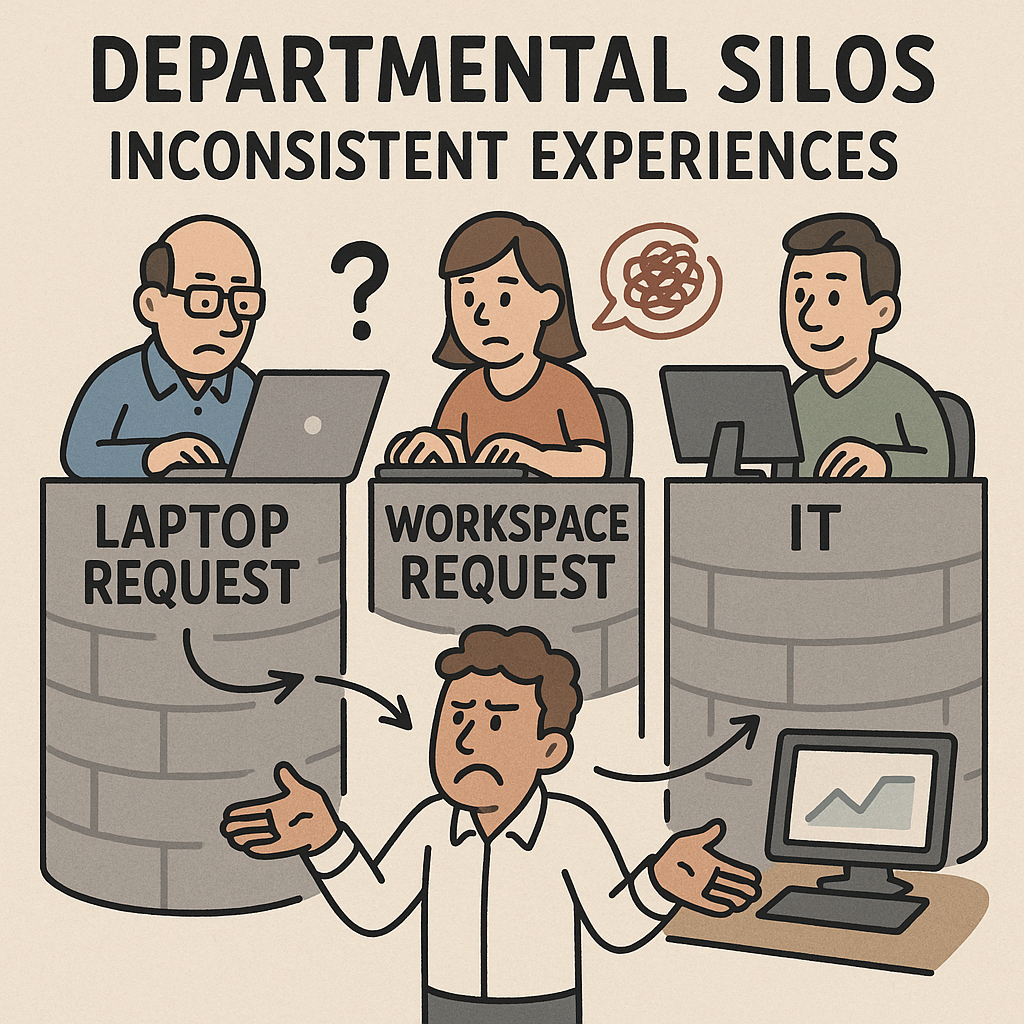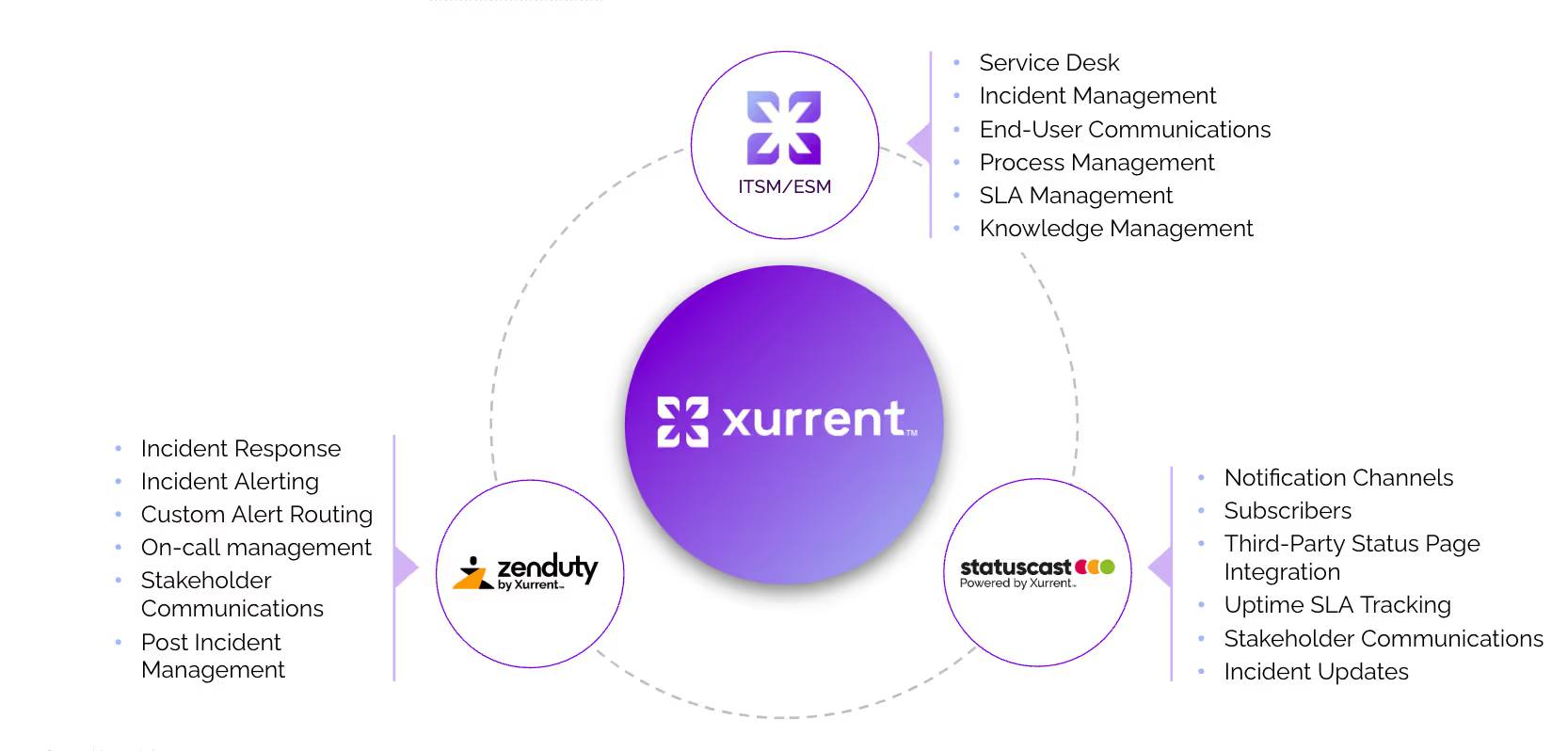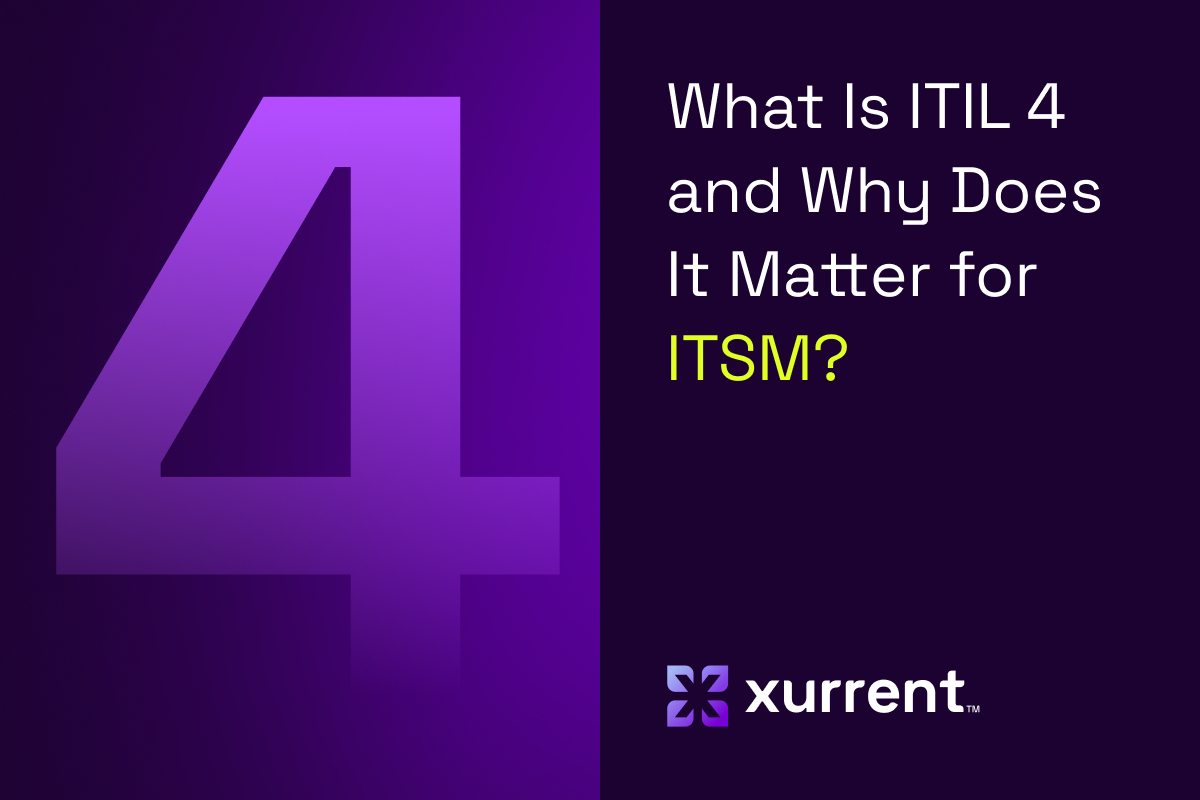How Enterprise Service Management (ESM) solves operational challenges across your entire company

While IT departments have mastered modern service management, the rest of the enterprise remains stuck in 'good'."
IT departments have transformed from reactive firefighting to proactive service delivery through automated workflows, unified ticketing, and measurable SLAs, but don’t excel at solving business process challenges.
HR departments still rely on lengthy email chains for onboarding despite being proficient at managing employee data and benefits administration.
Finance teams continue to struggle with manual approval workflows even though they're effective at budget tracking and financial reporting.
Facilities groups remain dependent on spreadsheets for workspace requests while maintaining physical spaces and assets efficiently.
The good news? The same principles that transformed IT operations can revolutionize your entire enterprise.
Let's start by examining what IT Service Management (ITSM) has done right.
The ITSM success story ... and its organizational blind spot
Over the past two decades, ITSM has fundamentally reimagined how IT operates.
For the most part, gone are the days of help desk tickets disappearing into black holes or changes being deployed without approval processes.

Today's IT organizations are adept at tracking each incident with precision, automating routine tasks that once required hours of manual effort, and maintaining service catalogs that provide employees with self-service access to a wide range of resources, from software licenses to hardware requests.
Luckily, this transformation runs deep.
Modern IT teams can predict and prevent outages using monitoring automation, resolve incidents faster through intelligent routing, and measure performance against clearly defined SLAs. What once required phone calls, emails, and manual handoffs now flows through integrated systems that provide real-time visibility from request to resolution.
But here's the organizational paradox: These same companies that can restore a critical server in under 10 minutes still require employees to wait two weeks for a simple laptop request because HR's onboarding process involves manual email chains and paper forms. IT solved the technology service delivery challenge, yet never extended those solutions to solve business service delivery challenges.
More good news: The invisible boundary isn't technical; it's organizational. And it’s fixable.
IT's success story stops at departmental lines, leaving the rest of the enterprise to struggle with the same manual, disconnected processes that IT abandoned years ago.
Where traditional (old school) ITSM bumps into limits
Even in organizations with more mature ITSM practices, 3 fundamental gaps often prevent enterprise-wide transformation:
1. Departmental silos create inconsistent experiences. Each department operates independent systems with different user interfaces, meaning a laptop request flows differently than a workspace request, which creates confusion. Service performance varies widely depending on which department owns the process, resulting in frustration for users who expect the same level of efficiency they experience with IT services.

2. Manual workflows persist outside IT's influence. New hire processes still require approvals across multiple departments, invoices are emailed to the accounts payable email address, making it impossible to know the current status without follow-up emails or conversations, and expense approvals create bottlenecks that slow business operations.
And these manual processes exist in the same organizations that have automated complex IT infrastructure management!
3. Leadership lacks enterprise-wide visibility. IT dashboards provide real-time visibility into server uptime and infrastructure health; yet, executives often remain utterly blind to employee satisfaction with HR services or Facilities performance. Resource allocation decisions frequently occur in silos, based on incomplete operational data, with no unified metrics to compare how well IT delivers services versus how effectively Finance processes approvals or HR handles onboarding. Leadership can spot a server issue within minutes, but has no idea that employees are frustrated with a two-week laptop procurement process.
The result? Organizations with world-class IT service delivery, but inconsistent, frustrating experiences everywhere else.
How Enterprise Service Management (ESM) extends ITSM principles beyond basic IT functions
ESM takes automated workflows, unified ticketing, and measurable service levels — those things that transformed IT operations — and applies them across the entire organization. Instead of each department operating independent systems, ESM creates a single platform where employees get the same streamlined experience whether they're requesting a laptop, booking a conference room, or submitting an expense report.

Here are 6 areas where ESM gets it right:
1. Employee experience consistency
Traditional ITSM delivers excellent IT support, yet it often falls short in other areas.
ESM creates seamless service experiences across all employee touchpoints and departments.
With ESM, the once arduous task becomes easy. So easy that often we don’t even notice, as we just take it for granted.
With ESM, it becomes easy to obtain a new laptop or order new office supplies, and simple to get new vendor approval or submit an expense report.
2. Cross-functional automation
Traditional ITSM automates IT processes in isolation while other departments remain stuck with manual handoffs.
ESM creates coordinated workflows that span multiple departments.
With ESM, new hire onboarding becomes a seamless workflow that spans HR (benefits enrollment), IT (equipment provisioning), Facilities (workspace assignment), and Finance (budget allocation).
3. Enterprise-wide visibility and resource optimization
Traditional ITSM provides IT efficiency improvements in isolation (siloed!), while leadership remains blind to service performance across other departments.
ESM creates unified dashboards showing real-time metrics across all functions.
With ESM, companies often see a 30% reduction in service delivery overhead thanks to resources being optimized across the entire organization rather than department by department.
4. Compliance and standardization at scale
Traditional ITSM ensures IT processes meet industry standards, while other departments often operate with varying compliance frameworks.
ESM extends consistent compliance controls across all service functions.
With ESM, organizations gain unified access controls and audit trails, enabling coordinated change management across organizational functions rather than ad-hoc business changes that bypass proper controls.
5. AI-powered intelligence across all functions
Traditional ITSM applies AI capabilities only to IT operations, while other departments miss out on productivity gains.
ESM applies the same AI capabilities to every department, not just IT.
With ESM, auto-classification is effective for HR requests, sentiment analysis accurately identifies employee satisfaction across all service types, and request summaries are automatically generated for finance approvals and facilities requests.
6. Scalability without operational complexity
Traditional ITSM requires process changes when adding new IT services, while other departments struggle with growth.
ESM enables organizations to expand service offerings across any department without proportional operational overhead.
With ESM, new departments and services integrate seamlessly into existing workflows, supporting business growth without creating an administrative burden.
But how do you justify making this investment in time and resources?
Making the ESM (and Xurrent) business case
The transformation from departmental silos to unified service management is both operationally smart and financially sound.
Organizations implementing ESM platforms such as Xurrent typically see implementation in 4 weeks rather than the "months and months" required for department-by-department solutions.
Instead of expensive 'add-on' based licensing models and multiple administrative overhead burdens, companies implementing Xurrent get a flexible, user-oriented license model with multi-tenant SaaS architecture that reduces administrative overhead.
ESMs like Xurrent provide unified data that enables better organizational decision-making, replacing the incomplete operational data that executives currently use for resource allocation. The consistent employee experience improves satisfaction and retention — no more frustration about why getting a laptop is easier than booking a conference room.
The future is now.
The future is cross-functional
ESM represents the natural evolution of service management by applying proven ITSM principles where they create the most value: across your entire organization. While traditional ITSM solved IT's operational challenges, ESM solves the enterprise's operational challenges.
ESM platforms like Xurrent get it right.
Get started with Xurrent today.
FAQs
1. What is Enterprise Service Management (ESM), and how does it differ from ITSM?
Enterprise Service Management (ESM) takes automated workflows, unified ticketing, and measurable service levels — those things that transformed IT operations — and applies them across the entire organization. Instead of each department operating independent systems, ESM creates a single platform where employees get the same streamlined experience whether they're requesting a laptop, booking a conference room, or submitting an expense report. While traditional ITSM solved IT's operational challenges, ESM solves the enterprise's operational challenges.
2. Why do organizations with excellent IT service management still struggle with other business processes?
IT departments have transformed from reactive firefighting to proactive service delivery through automated workflows, unified ticketing, and measurable SLAs, but don't excel at solving business process challenges. The organizational paradox is that companies that can restore a critical server in under 10 minutes still require employees to wait two weeks for a simple laptop request because HR's onboarding process involves manual email chains and paper forms. IT's success story stops at departmental lines, leaving the rest of the enterprise to struggle with the same manual, disconnected processes that IT abandoned years ago.
3. What are the main limitations of traditional ITSM implementations?
Even in organizations with more mature ITSM practices, three fundamental gaps often prevent enterprise-wide transformation: departmental silos create inconsistent experiences with different user interfaces and varying service performance; manual workflows persist outside IT's influence with processes like new hire approvals still requiring physical signatures across multiple departments; and leadership lacks enterprise-wide visibility, with executives remaining blind to employee satisfaction with HR services or Facilities performance while having real-time visibility into IT infrastructure health.
4. How does ESM improve employee experience consistency across departments?
ESM creates seamless service experiences across all employee touchpoints and departments. With ESM, getting a laptop is as easy as booking a conference room, submitting an expense report, requesting time off, ordering office supplies, scheduling facility maintenance, or obtaining approval for a new vendor. This eliminates the confusion created when different departments operate independent systems with different user interfaces.
5. What does cross-functional automation mean in Enterprise Service Management?
Traditional ITSM automates IT processes in isolation while other departments remain stuck with manual handoffs. ESM creates coordinated workflows that span multiple departments. With ESM, new hire onboarding becomes a seamless workflow that spans HR (benefits enrollment), IT (equipment provisioning), Facilities (workspace assignment), and Finance (budget allocation), eliminating the manual email chains and paper forms that previously slowed down these processes.
6. How does ESM provide better visibility and resource optimization for leadership?
ESM creates unified dashboards showing real-time metrics across all functions, replacing the incomplete operational data that executives currently use for resource allocation. While leadership can spot a server issue within minutes, they often have no idea that employees are frustrated with a two-week laptop procurement process. With ESM, companies often see a 30% reduction in service delivery overhead thanks to resources being optimized across the entire organization rather than department by department.
7. How does ESM handle compliance and standardization across different departments?
Traditional ITSM ensures IT processes meet industry standards, while other departments often operate with varying compliance frameworks. ESM extends consistent compliance controls across all service functions. With ESM, organizations gain unified access controls and audit trails, enabling coordinated change management across organizational functions rather than ad-hoc business changes that bypass proper controls.
8. Can AI capabilities be applied across all departments with ESM?
Yes, ESM applies AI capabilities to every department, not just IT. Traditional ITSM applies AI capabilities only to IT operations, while other departments miss out on productivity gains. With ESM, auto-classification is effective for HR requests, sentiment analysis accurately identifies employee satisfaction across all service types, and request summaries are automatically generated for finance approvals and facilities requests.
9. How quickly can organizations implement ESM platforms like Xurrent?
Organizations implementing ESM platforms such as Xurrent typically see implementation in 4 weeks rather than the "months and months" required for department-by-department solutions. Instead of expensive 'add-on' based licensing models and multiple administrative overhead burdens, companies implementing Xurrent get a flexible, user-oriented license model with multi-tenant SaaS architecture that reduces administrative overhead.
10. What business benefits can organizations expect from implementing ESM?
ESM provides unified data that enables better organizational decision-making, replacing incomplete operational data that executives currently use for resource allocation. The consistent employee experience improves satisfaction and retention — eliminating frustration about why getting a laptop is easier than booking a conference room. Companies often see a 30% reduction in service delivery overhead thanks to resources being optimized across the entire organization, and ESM enables organizations to expand service offerings across any department without proportional operational overhead.

Xurrent named a Market Leader in Research In Action’s Vendor Selection Matrix™ for IT & Enterprise Service Management Solutions
Xurrent earns #1 rankings in customer satisfaction, price vs value, and recommendation index in Research In Action's global ITSM/ESM Vendor Selection Matrix report.





